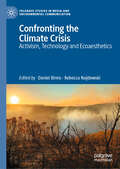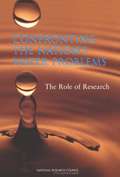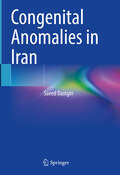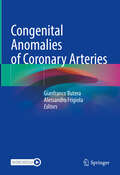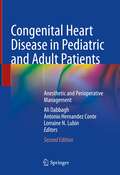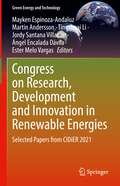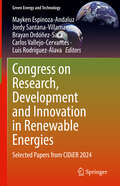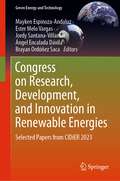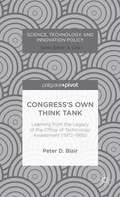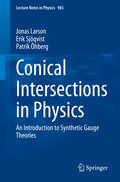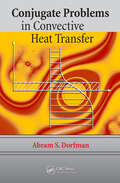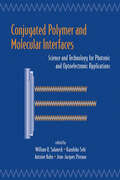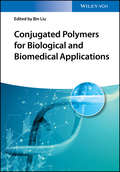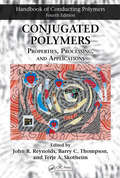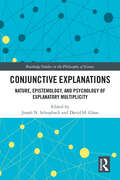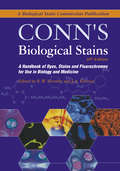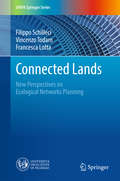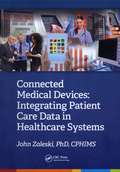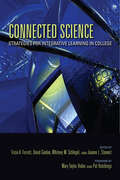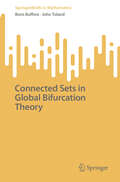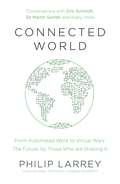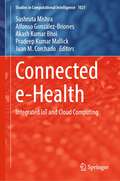- Table View
- List View
Confronting the Climate Crisis: Activism, Technology and Ecoaesthetics (Palgrave Studies in Media and Environmental Communication)
by Daniel Binns Rebecca NajdowskiThis collection examines how activism, media, and creative practices shape our understanding of the climate crisis. Bringing together perspectives from media studies, environmental humanities, and artistic research, Confronting the Climate Crisis: Activism, Technology and Ecoaesthetics explores how digital technologies, protest movements, and ecoaesthetic interventions influence ecological discourse. Fifteen chapters interrogate a range of case studies, from student activism and climate-related art to the role of video games, memes, and machine learning in framing and comprehending environmental collapse. The collection also considers how experimental cinema, podcasts, and documentary practices can move beyond entertainment and spectacle to foster lasting and meaningful action against environmental change. Highlighting the intersections of politics, technology, and aesthetics, this book offers a vital resource for scholars, artists, and activists seeking to navigate and challenge contemporary climate narratives. It argues that creative and technological interventions are essential to rethinking our relationship with the planet and shaping new modes of ecological action.
Confronting the Nation's Water Problems: The Role of Research
by Committee on Assessment of Water Resources ResearchIn order to confront the increasingly severe water problems faced by all parts of the country, the United States needs to make a new commitment to research on water resources. A new mechanism is needed to coordinate water research currently fragmented among nearly 20 federal agencies. Given the competition for water among farmers, communities, aquatic ecosystems and other users-as well as emerging challenges such as climate change and the threat of waterborne diseases-Confronting the Nation's Water Problems concludes that an additional $70 million in federal funding should go annually to water research. Funding should go specifically to the areas of water demand and use, water supply augmentation, and other institutional research topics. The book notes that overall federal funding for water research has been stagnant in real terms for the past 30 years and that the portion dedicated to research on water use and social science topics has declined considerably.
Congenital Anomalies in Iran
by Saeed DastgiriThis book explores the magnitude of the congenital anomalies and developmental disabilities based on the data from an established surveillance and prevention program of congenital defects, and describing the successful strategies for the control of neural tube defects, Down syndrome, phenylketonuria, haemophilia, thalassemia and some other defects in the country.It provides essential data for research purposes, information for health service planners, clinicians, and for genetic counselling. This book will be a unique source of evidences from a developing country with notable similar applications in other areas and countries of developing world.
Congenital Anomalies of Coronary Arteries
by Gianfranco Butera Alessandro FrigiolaThe coronaries are the first branches of the ascending aorta. They arise from their respective sinuses of Valsalva, and gradually branch distally to the myocardium. Abnormalities of the coronary arteries, either congenital or acquired, can be characterized as a lack of origin, abnormal origin, anomalous course, lack of patency, abnormal connections, and/or abnormal drainage of the coronary vessels. Interruptions to or lack of flow can cause significant morbidity and mortality due to ischemia, infarction and fistulous connections, which can lead to cardiac failure, endocarditis and ischemia. Coronary artery anomalies are rare in general populations. Although they can be benign and asymptomatic, they can also be malignant due to their origin and course and can cause sudden cardiac death. As such, an understanding of how to analyze, diagnose and treat them is vital. This book presents the latest advances in congenital anomalies of coronary arteries. It offers a comprehensive overview of the field, including illustrative angiograms and diagrams that demonstrate all possible anomalies and clarify what is abnormal, and also provides practical insights to guide practitioners in their everyday practice.
Congenital Heart Disease in Pediatric and Adult Patients: Anesthetic and Perioperative Management
by Ali Dabbagh Antonio Hernandez Conte Lorraine N. LubinThe second edition of this critical text features heavily revised chapters detailing how to approach the anesthetic and perioperative management of adult and pediatric patients with congenital heart disease. Initially, a broad overview of relevant concepts in pediatric cardiovascular embryology, physiology, and pharmacology is provided. Subsequently, relevant diagnostic approaches including the use of three-dimensional modeling in surgical planning and preoperative considerations are described. The intraoperative management of a wide range of specific lesions is discussed, with full descriptions of anesthesia plans and the appropriate diagnostic methods and surgical interventions. New topics detailed include the use of hybrid techniques and applications of electrophysiology in patients with congenital heart disease. Postoperative care and potential future approaches are also addressed.Congenital Heart Disease in Pediatric and Adult Patients: Anesthetic and Perioperative Management provide a comprehensive, up-to-date overview of the care of the pediatric patient undergoing cardiac surgery and anesthesia. It is therefore of interest to all practicing and trainee medical professionals who encounter these patients in their day-to-day practice.
Congress on Research, Development and Innovation in Renewable Energies: Selected Papers from CIDiER 2021 (Green Energy and Technology)
by Martin Andersson Mayken Espinoza-Andaluz Tingshuai Li Jordy Santana Villamar Ángel Encalada Dávila Ester Melo VargasThe 2021 Congress on Research, Development and Innovation in Renewable Energies (CIDiER 2021) aims to promote international collaboration that fosters ideas and dialogue on developing a solution to climate change through research and development that leads to clean energy innovation via renewable energies. These selected papers cover both theoretical and applied research that will strengthen the implementation of renewable energy projects between universities, research centers, and private companies.
Congress on Research, Development and Innovation in Renewable Energies: Selected Papers from CIDiER 2024 (Green Energy and Technology)
by Mayken Espinoza-Andaluz Jordy Santana-Villamar Brayan Ordóñez-Saca Carlos Vallejo-Cervantes Luis Rodríguez-ÁlavaRenewable Energy Research, Development, and Innovation: Selected Papers from CIDiER 2024 presents international collaborations that foster ideas and dialogue around solutions to climate change through research and development that leads to clean energy innovation via renewable energies. The book includes chapters based on selected papers from the 2024 Congress on Research, Development, and Innovation in Renewable Energies (CIDiER 2024) that cover theoretical and applied research that will strengthen the implementation of renewable energy projects between universities, research centers, and private companies in Latin America. Presents leading-edge research on advancing renewable energy; Promotes research and innovation with a focus on Latin America; Covers biomass, hydraulic, hydrogen, tidal, solar, and wind energy.
Congress on Research, Development, and Innovation in Renewable Energies: Selected Papers from CIDiER 2022 (Green Energy and Technology)
by Mayken Espinoza-Andaluz Jordy Santana Villamar Ester Melo Vargas Ángel Encalada-DávilaThe 2022 Congress on Research, Development, and Innovation in Renewable Energies (CIDiER 2022) promotes international collaboration on ideas and dialogue around climate change solutions through research and development that leads to clean energy innovation via renewable energies. The selected papers cover both theoretical and applied research that will strengthen the implementation of renewable energy projects between universities, research centers, and private companies in Latin America.
Congress on Research, Development, and Innovation in Renewable Energies: Selected Papers from CIDiER 2023 (Green Energy and Technology)
by Mayken Espinoza-Andaluz Ángel Encalada Dávila Ester Melo Vargas Jordy Santana-Villamar Brayan Ordóñez SacaThe 2023 Congress on Research, Development, and Innovation in Renewable Energies (CIDiER 2022) promotes international collaboration fostering ideas and dialogue around solutions to climate change through research and development that leads to clean energy innovation via renewable energies. These selected papers cover theoretical and applied research that will strengthen the implementation of renewable energy projects between universities, research centers, and private companies in Latin America.
Congress’s Own Think Tank: Learning from the Legacy of the Office of Technology Assessment (1973–1995)
by Peter D. BlairCongress' Own Think Tank recaps the OTA experience--it's creation, operation, and circumstances of its closure-- and that of organizations attempting to fill the gap since OTA's closure as well as a number of new forces shaping the current context for science and technology issues facing the Congress.
Conical Intersections in Physics: An Introduction to Synthetic Gauge Theories (Lecture Notes in Physics #965)
by Patrik Öhberg Jonas Larson Erik SjöqvistThis concise book introduces and discusses the basic theory of conical intersections with applications in atomic, molecular and condensed matter physics. Conical intersections are linked to the energy of quantum systems. They can occur in any physical system characterized by both slow and fast degrees of freedom - such as e.g. the fast electrons and slow nuclei of a vibrating and rotating molecule - and are important when studying the evolution of quantum systems controlled by classical parameters. Furthermore, they play a relevant role for understanding the topological properties of condensed matter systems. Conical intersections are associated with many interesting features, such as a breakdown of the Born-Oppenheimer approximation and the appearance of nontrivial artificial gauge structures, similar to the Aharonov-Bohm effect. Some applications presented in this book include - Molecular Systems: some molecules in nonlinear nuclear configurations undergo Jahn-Teller distortions under which the molecule lower their symmetry if the electronic states belong to a degenerate irreducible representation of the molecular point group. - Solid State Physics: different types of Berry phases associated with conical intersections can be used to detect topologically nontrivial states of matter, such as topological insulators, Weyl semi-metals, as well as Majorana fermions in superconductors. - Cold Atoms: the motion of cold atoms in slowly varying inhomogeneous laser fields is governed by artificial gauge fields that arise when averaging over the fast internal degrees of freedom of the atoms. These gauge fields can be Abelian or non-Abelian, which opens up the possibility to create analogs to various relativistic effects at low speed.
Coniferous Forests
by Donna LathamInvestigating a variety of biomes and today's natural and human threats to their preservation, this interactive series challenges young readers to look at how their own actions influence the planet's health. Four distinct environments are explored in detail, showcasing the assortment of plants and animals that inhabit these outdoor communities as well as how they have adapted to their surroundings. Offering fascinating facts on each ecosystem along with vocabulary-building sidebars, these guides show budding scientists how they can contribute towards ongoing conservation efforts. The diverse woodland of coniferous forests is revealed in this detailed resource, covering topics such as the dangers of deforestation, over hunting, and forest fires, illustrating the rapid decline of this ecosystem's biodiversity.
Conjugate Problems in Convective Heat Transfer (Heat Transfer)
by Abram S. DorfmanIllustrates Calculations Using Machine and Technological ProcessesThe conjugate heat transfer (CHT) problem addresses the thermal interaction between a body and fluid flowing over or through it. This is an essential consideration in nature and different areas of engineering, including mechanics, aerospace, nuclear engineering, biology, and meteorol
Conjugated Polymer And Molecular Interfaces: Science And Technology For Photonic And Optoelectronic Application
by William R. Salaneck Kazuhiko Seki Antoine Kahn Jean-Jacques PireauxDefines the state-of-the-art in interface science for electronic applications of organic materials. Updates understanding of the foundaiton of interfacial properties. Describes novel electronic devices created from conjugated polymers and organic molecular solids.
Conjugated Polymers for Biological and Biomedical Applications
by Bin LiuThis first book to specifically focus on applications of conjugated polymers in the fields of biology and biomedicine covers materials science, physical principles, and nanotechnology. The editor and authors, all pioneers and experts with extensive research experience in the field, firstly introduce the synthesis and optical properties of various conjugated polymers, highlighting how to make organic soluble polymers compatible with the aqueous environment. This is followed by the application of these materials in optical sensing and imaging as well as the emerging applications in image-guided therapy and in the treatment of neurodegenerative diseases. The result is a consolidated overview for polymer chemists, materials scientists, biochemists, biotechnologists, and bioengineers.
Conjugated Polymers: Properties, Processing, and Applications (Polymer Chemistry Ser. #Volume 9)
by John R. Reynolds Barry C. Thompson Terje A. SkotheimThis book covers properties, processing, and applications of conducting polymers. It discusses properties and characterization, including photophysics and transport. It then moves to processing and morphology of conducting polymers, covering such topics as printing, thermal processing, morphology evolution, conducting polymer composites, thin films
Conjunctive Explanations: The Nature, Epistemology, and Psychology of Explanatory Multiplicity (Routledge Studies in the Philosophy of Science)
by David H. Glass Jonah N. SchupbachPhilosophers and psychologists are increasingly investigating the conditions under which multiple explanations are better in conjunction than they are individually. This book brings together leading scholars to provide an interdisciplinary and unified discussion of such “conjunctive explanations.” The book starts with an introductory chapter expounding the notion of conjunctive explanation and motivating a multifaceted approach to its study. The remaining chapters are divided into three parts. Part I includes chapters on “The Nature of Conjunctive Explanations.” Each chapter illustrates distinct ways in which explanatory multiplicity is motivated by a careful study of the nature and concept of explanation. The second part (“Reasoning About Conjunctive Explanations”) includes chapters on the epistemology and logic of conjunctive explanations. Here the contributors propose and evaluate various norms for reasoning correctly about and to conjunctive explanations. Part III concerns “The Psychology of Conjunctive Explanations,” with contributions discussing conditions under which humans entertain and hold multiple explanations of single explananda simultaneously and the cognitive limitations and capacities for doing so. Conjunctive Explanations will be of interest to researchers and advanced students working on explanation in philosophy of science, epistemology, philosophical logic, and cognitive psychology.
Conn's Biological Stains: A Handbook of Dyes, Stains and Fluorochromes for Use in Biology and Medicine
by Richard W. Horobin and John A. KiernanPublished on behalf of the Biological Stain CommissionFor 75 years Conn's Biological Stains has been a standard reference for all those who used dyes and colorants in the biological and medical sciences. This long awaited tenth edition appears 25 years after R.D. Lillie's ninth and has been completely rewritten to reflect the increase in range of uses. Although the staining of microscopical preparations continues to expand the uses of dyes and fluorochromes now extend far beyond this traditional application.This book provides the first critical overview of the whole range of low molecular weight fluorescent probes, outside the catalogue literature. The first ten chapters are essays, by leading experts, on the important aspects of colorants and their uses. Most of the remainder of the book consists of descriptions by Dr Horobin of the properties and recent applications of hundreds of individual compounds, in about twenty chemical classes. The last chapter reviews the procedures employed at the Biological Stain Commission's laboratory to assay and test dyes and certify them as suitable for their intended applications.
Connected Lands: New Perspectives on Ecological Networks Planning (UNIPA Springer Series)
by Filippo Schilleci Vincenzo Todaro Francesca LottaThis book explores and outlines the reference theoretical basis of ecological networks within the international debate, focusing on how protected areas should no longer be considered as the sum of different components but rather as a network. The various European, transnational and national models of ecological networks/connections are analyzed on the basis of a detailed, updated study of relevant documents. The complex picture that emerges shows a wide range of reticular-ecological models within European plans and programs, but also many non-integrated experiences. The book subsequently examines the regulation of ecological networks/connections within planning instruments, explaining the critical points and referring to different ecological network models and specific local realities. Lastly, the book addresses two Italian case studies regarding the different normative and planning frameworks, both at a national and regional level, and demonstrating not only how ecological networks/connections can be structured within plans, but also how these networks/connections represent the core element of territory development and preservation. As such, it provides an essential tool for containing habitat fragmentation, offering a new perspective that integrates theoretical approaches and methods with planning models and the lessons learned from local applications.
Connected Mathematics: Stretching and Shrinking (Similarity)
by Glenda Lappan James T. Fey William M. Fitzgerald Susan N. Friel Elizabeth Difanis PhillipsStretching and Shrinking explores the geometry concept of similarity.
Connected Medical Devices: Integrating Patient Care Data in Healthcare Systems (HIMSS Book Series)
by John ZaleskiThis book explores how medical device integration (MDI) supports quality patient care and better clinical outcomes by reducing clinical documentation transcription errors, improving data accuracy and density within clinical records and ensuring the complete capture of medical device information on patients. It begins with a comprehensive overview of the types of medical devices in use and the ways in which those devices interact, then examines factors such as interoperability standards, patient identification, clinical alerts and regulatory and security considerations.
Connected Science: Strategies for Integrative Learning in College (Scholarship Of Teaching And Learning Ser.)
by Tricia A. Ferrett, David R. Geelan, Whitney M. Schlegel, and Joanne L. StewartInformed by the scholarship of teaching and learning (SOTL), Connected Science presents a new approach to college science education for the 21st century. This interdisciplinary approach stresses integrative learning and pedagogies that engage students through open-ended inquiry, compelling real-world questions, and data-rich experiences. Faculty from a variety of disciplines and institutions present case studies based on research in the classroom, offering insights into student learning goals and best practices in curriculum design. Synthetic chapters bring together themes from the case studies, present an overview of the connected science approach, and identify strategies and future challenges to help move this work forward.
Connected Sets in Global Bifurcation Theory (SpringerBriefs in Mathematics)
by John Toland Boris BuffoniThis book explores the topological properties of connected and path-connected solution sets for nonlinear equations in Banach spaces, focusing on the distinction between these concepts. Building on Rabinowitz's dichotomy and classical results on Peano continua, the authors introduce "congestion points"—where connected sets fail to be weakly locally connected—and examine the extent to which their presence is compatible with path-connectedness. Through rigorous analysis and examples, the book provides new insights into global bifurcations. Structured into seven chapters, the book begins with an introduction to global bifurcation theory and foundational concepts in set theory and metric spaces. Subsequent chapters delve into connectedness, local connectedness, and congestion points, culminating in the construction of intricate examples that highlight the complexities of solution sets. The authors' careful selection of material and fluent writing style make this work a valuable resource for PhD students and experts in functional analysis and bifurcation theory.
Connected World: From Automated Work to Virtual Wars: The Future, By Those Who Are Shaping It
by Father Philip LarreyThe world as we know it is changing. Driverless cars, drone deliveries and autonomous weapon systems are no longer the stuff of science fiction.But what's next for technology and business, and how will it impact our society?In Connected World, Philip Larrey of the Pontifical Lateran University explores the consequences of the new digital age in conversation with leaders including Sir Martin Sorrell, CEO of WPP, Eric Schmidt, CEO of Google's parent company Alphabet, and Maurice Lévy, CEO of Publicis Groupe.Ranging from the death of privacy to the rise of artificial intelligence, Connected World asks the existential questions which will come to define our age.
Connected e-Health: Integrated IoT and Cloud Computing (Studies in Computational Intelligence #1021)
by Juan M. Corchado Akash Kumar Bhoi Pradeep Kumar Mallick Alfonso González-Briones Sushruta MishraWith rise of smart medical sensors, cloud computing and the health care technologies, “connected health” is getting remarkable consideration everywhere. Recently, the Internet of Things (IoT) has brought the vision of a smarter world into reality. Cloud computing fits well in this scenario as it can provide high quality of clinical experience. Thus an IoT-cloud convergence can play a vital role in healthcare by offering better insight of heterogeneous healthcare content supporting quality care. It can also support powerful processing and storage facilities of huge data to provide automated decision making. This book aims to report quality research on recent advances towards IoT-Cloud convergence for smart healthcare, more specifically to the state-of-the-art approaches, design, development and innovative use of those convergence methods for providing insights into healthcare service demands. Students, researchers, and medical experts in the field of information technology, medicine, cloud computing, soft computing technologies, IoT and the related fields can benefit from this handbook in handling real-time challenges in healthcare. Current books are limited to focus either on soft computing algorithms or smart healthcare. Integration of smart and cloud computing models in healthcare resulting in connected health is explored in detail in this book.
